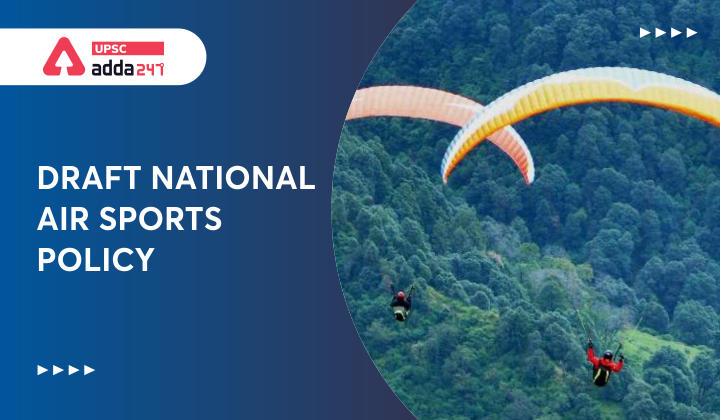Table of Contents
National Air Sports Policy (NASP 2022)- Relevance for UPSC Exam
- GS Paper 2: Governance, Administration and Challenges- Government policies and interventions for development in various sectors and issues arising out of their design and implementation.
National Air Sports Policy (NASP)- Context
- Recently, the Ministry of Civil Aviation released a draft National Air Sports Policy (NASP) for public feedback. The draft policy is available on the website of the Civil Aviation Ministry.
National Air Sports Policy (NASP 2022)- Key Points
- About: Draft National Air Sports Policy (NASP 2022) aims to promote the country’s air sports sector, by way of making it safe, affordable, accessible, enjoyable, and sustainable.
- The potential of Air Sports: India has the potential to be among the leading nations in the world of air sports due to the following-
- India has a large geographical expanse, diverse topography, and fair-weather conditions.
- It has a large population, especially the youth.
- It has a growing culture for adventure sports and aviation.
- Associated Benefits: Other than the direct revenue from air sports activities, the multiplier benefits in terms of growth of travel, tourism, infrastructure and local employment, especially in hilly areas of the country, are several times greater.
- The creation of air sports hubs across the country will also bring in air sports professionals and tourists from across the world.
Draft National Air Sports Policy (NASP 2022)- Key Features
- Sports covered: NASP 2022 covers sports like-
- Aerobatics, aeromodelling, amateur-built and experimental aircraft, ballooning, drones, gliding, hang gliding and paragliding;
- Micro-lighting and paramotoring;
- Skydiving and vintage aircraft.
- Vision: NSASP 2022 aims to make India one of the top air sports nations by 2030.
- The mission is to provide a safe, affordable, accessible, enjoyable and sustainable air sports ecosystem in India.
- Exploiting India’s air sports Potential: NASP 2022 seeks to leverage India’s huge potential for air sports given its large geographical expanse, diverse topography and fair-weather conditions.
- Implementation: An Air Sports Federation of India (ASFI) will be established as the apex governing body.
- Associations for each air sport will handle day-to-day activities e.g. Paragliding Association of India or the Skydiving Association of India etc.
- The air sports associations shall be accountable to ASFI with respect to the regulatory oversight and for providing safe, affordable, accessible, enjoyable and sustainable conduct of their respective air sport.
- Representation at Global Flora: ASFI shall represent India at FAI and other global platforms related to air sports.
- Greater participation and success of Indian sportspersons in global air sports events will be facilitated.
- Promoting Atmanirbhar Bharat: Domestic design, development and manufacturing of air sports equipment will be promoted in line with the Atmanirbhar Bharat Abhiyan.
- Conforming with Global Standards: All competitions in India will be conducted as per the guidelines laid down by the Fédération Aéronautique Internationale (FAI).
- FAI IS headquartered in Lausanne, Switzerland is the world governing body for air sports.
- NASP 2022 places a strong focus on ensuring international best practices in safety.
- Ensuring Safety standards: Inability to enforce safety standards by an air sports association may lead to penal action by the ASFI against such association including financial penalties, suspension or dismissal.
- Promoting Participation: Schools, colleges and universities will be encouraged to have air sports included in their curriculum.
- Funding: Long-term funding for the development of air sports in India shall come from corporate investors, sponsors, membership fees, events and media rights.
- ASFI may seek financial support from the Government of India for the promotion of air sports, especially in the initial years.
- Ensuring Accessibility: To make air sports affordable to the common public, the Government will request the GST Council to consider rationalizing the GST rate on-air sports equipment to 5% or less.



 TSPSC Group 1 Question Paper 2024, Downl...
TSPSC Group 1 Question Paper 2024, Downl...
 TSPSC Group 1 Answer key 2024 Out, Downl...
TSPSC Group 1 Answer key 2024 Out, Downl...
 UPSC Prelims 2024 Question Paper, Downlo...
UPSC Prelims 2024 Question Paper, Downlo...




